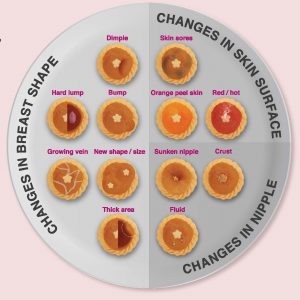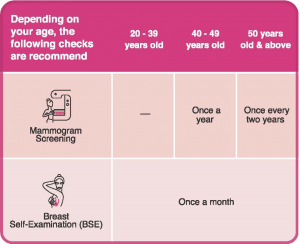
For patients
What are some signs and symptoms of breast cancer I should look out for during self-examination?⁽¹⁾
When performing a self-examination, here are some things to take note of:
A lump, hard knot or area of thickened tissue in the breast
A lump in the underarm area
Change in the size or shape of your breast
Nipple pain, tenderness or discharge, including bleeding
Itchiness, scales, soreness or rash on nipple
Nipple turning inward or inverted
Change in skin color and texture, such as dimpling, puckering or redness
Breast that feels warm or swollen
How can I perform a self-examination?⁽²⁾
The early diagnosis and treatment of breast cancer vastly improves your chances of fighting the disease. Doing a DIY breast self-examination every month helps familiarise yourself with the condition of your breast and makes it easier to notice any changes.
It is recommended to perform your breast self-check while lying down on the bed or in front of the mirror. It is best to do so 7 to 10 days after the start of your period, when your breasts are least tender. If you no longer have periods, then choose a date that is easy to remember.
Overall, the most important thing is to Look, Touch and Check.
Look out for changes in breast shape, skin surface and nipple abnormalities
Touch and feel your breast using your middle 3 fingers, moving in a circular motion from outer area towards the nipple
Check for lumps by examining your entire breast from your armpit to your cleavage with different pressure
 Consult your doctor should you detect any of the above changes. Most lumps or changes in the breast are not cancerous. Nevertheless, it is important to have them checked as soon as possible as a precaution.
Consult your doctor should you detect any of the above changes. Most lumps or changes in the breast are not cancerous. Nevertheless, it is important to have them checked as soon as possible as a precaution.
What determines your prognosis?⁽³⁾
The key factors that will determine your prognosis and treatment plan are the type and stage of breast cancer you have.
Stage of breast cancer:
The earlier the stage of your breast cancer, the higher your chances of survival. Your prognosis becomes worse as breast cancer advances. Therefore, it is important to receive a diagnosis and start treatment early.
Type of breast cancer:
The three main types of breast cancers are HER2-Positive, Hormone Receptor-Positive and Triple-Negative Breast Cancers. Depending on the type of cancer, the tumour will have different biological behaviours and prognoses.
What are treatment decisions based on?⁽⁴⁾
A breast cancer patient’s treatment plan is influenced by these factors:
The specific type of breast cancer diagnosed and the biology of the tumour
The stage of the breast cancer
Overall health, age and other medical issues
Patient’s prior treatment history
Preferences of the patient and physician
For Neoadjuvant/Adjuvant patients
How soon do I need to start treatment?⁽⁵⁾
While cancer treatment should start soon after diagnosis, for most cancers it is all right if you take some time to make a decision about your treatment options. This will give you time to talk about your treatment plan with your family, friends and team of healthcare professionals before deciding what is best for you.
What happens after my Neoadjuvant treatment?⁽⁶⁾
After your neoadjuvant therapy, your doctor will perform medical examinations in order to evaluate your tumour’s response to the treatment, and to examine how much of the tumour is left in the breast and lymph nodes. This can be done through a clinical breast exam, a mammogram, a breast MRI and/or a breast ultrasound.
Based on your neoadjuvant treatment outcomes, your doctor will recommend the appropriate surgery options to remove the remaining tumour. Your doctor will also examine how much of the tumour is left in the breast and lymph nodes after neoadjuvant therapy. The surgical specimen will be examined by a pathologist to see how much tumor is left in the breast and lymph nodes after neoadjuvant therapy.
Will my cancer get worse or tumour grow during neoadjuvant treatment?⁽⁷⁾
Most studies have shown that very few patients will get worse during neoadjuvant therapy, up to 3%. Your doctor will continue to monitor the tumour during treatment to ensure it is not growing. If necessary, the treatment regimen may be adjusted.
For Surgery patients
Why do I still need to go for surgery?⁽⁸⁾
Surgery is one of the main treatments for cancer with the goal of removing cancer cells from your breast. While neoadjuvant may shrink the tumour, surgery is still required to:
There are different types of breast surgery and your doctor may recommend the best one for you based on the size and stage of your cancer, and your treatment goals and preferences.
Remove the tumour bed area
Examine the tumour response to neoadjuvant treatment
Quality of life
What are some symptoms of Advanced Breast Cancer (ABC)?⁽⁹⁾
Patients with ABC may not have any symptoms. The symptoms which patients may have depends on where in the body the breast cancer is affecting. Some potential symptoms which patients may experience include:
Constant back, bone, or joint pain
Difficulty with urinating (either incontinence or not being able to go); this can be a sign that the nerves in your back are being pinched by a cancer
Numbness or weakness anywhere in your body
A constant dry cough
Difficulty breathing
Shortness of breath
Chest pain
Loss of appetite
Abdominal bloating, pain, or tenderness
Weight loss
Constant nausea, vomiting
Jaundice (a yellow tinge to the skin and whites of your eyes)
Severe headaches
Vision problems (blurry vision, double vision, loss of vision)
Seizures
Loss of balance
Confusion
Will my treatment affect my daily life?
Not necessarily. Each person reacts to their treatment differently. While some may feel fine after systemic therapy, others may find the side effects impacting their daily activities. If you feel that your daily life has been affected, do consult your doctor for advice on making any adjustments to your lifestyle.
References:
(1) Mayo Clinic. Breast self-exam for breast awareness. Mayo Foundation for Medical Education and Research. 2020. Available at https://www.mayoclinic.org/tests-procedures/breast-exam/about/pac-20393237 [Accessed May 2021]
(2) Singapore Cancer Society. Breast Self-Examination. 2016. Available at https://www.singaporecancersociety.org.sg/get-screened/breast-cancer/breast-self-examination.html#what-are-some-of-the-changes-to-look-out-for [Accessed May 2021]
(3) Tiersten, A. Breast Cancer Prognosis: Survival Rates by Stage, Age, and Race. Healthline. 2021. Available at https://www.healthline.com/health/breast-cancer/survival-facts-statistics [Accessed May 2021]
(4) Cancer.Net. Breast Cancer: Types of Treatment. American Society of Clinical Oncology. 2020. Available at https://www.cancer.net/cancer-types/breast-cancer/types-treatment [Accessed May 2021]
(5) American Cancer Society. Understanding the Cancer Experience When You’re a Caregiver. 2016. Available from: https://www.cancer.org/treatment/caregivers/what-a-caregiver-does/treatment-timeline.html [Accessed August 2020]
(6) Cancer Network. Neoadjuvant Therapy for Early-Stage Breast Cancer: Current Practice, Controversies, and Future Directions. 2020. Available at https://www.cancernetwork.com/view/neoadjuvant-therapy-early-stage-breast-cancer-current-practice-controversies-and-future-directions [Accessed May 2021]
(7) Caudle AS, et al. Impact of progression during neoadjuvant chemotherapy on surgical management of breast cancer. Ann Surg Oncol. 2011;18:932-938.
(8) Mayo Clinic. Breast Cancer Surgery. Mayo Foundation for Medical Education and Research. 2021. Available from: https://www.mayoclinic.org/tests-procedures/breast-cancer-surgery/about/pac-20385255 [Accessed August 2020].
(9) Breastcancer.org. Metastatic Breast Cancer Symptoms and Diagnosis. 2018. Available at https://www.breastcancer.org/symptoms/types/recur_metast/metastic. [Accessed May 2021]

